Abstract

On 22 May 2021, Mount Nyiragongo spewed ash, sulfurous gases, and fiery red lava, forcing thousands of people in Goma, Democratic Republic of the Congo (DRC)—“the city on the volcano”—to flee for their lives. Rising above the African Rift Valley, the volcano has the largest lava lake in the world, which locals once believed held the souls of their ancestors.1,2 Nyiragongo, infamous for its fast-flowing lava,3 last had major eruptions in 1977 and 2002. Its sister volcano, Nyamuragira— away—erupts more regularly but is farther from the population.3
When Nyiragongo erupted last May, “I saw people with luggage running away saying that the volcano is erupting,” says Guerchom Ndebo, a Congolese photojournalist and Goma resident. “In the street the people did not know which direction to take. [It was] total panic.” More than 364,000 individuals fled the region,4 more than 4,000 families lost their homes,4 and at least 31 people died.5
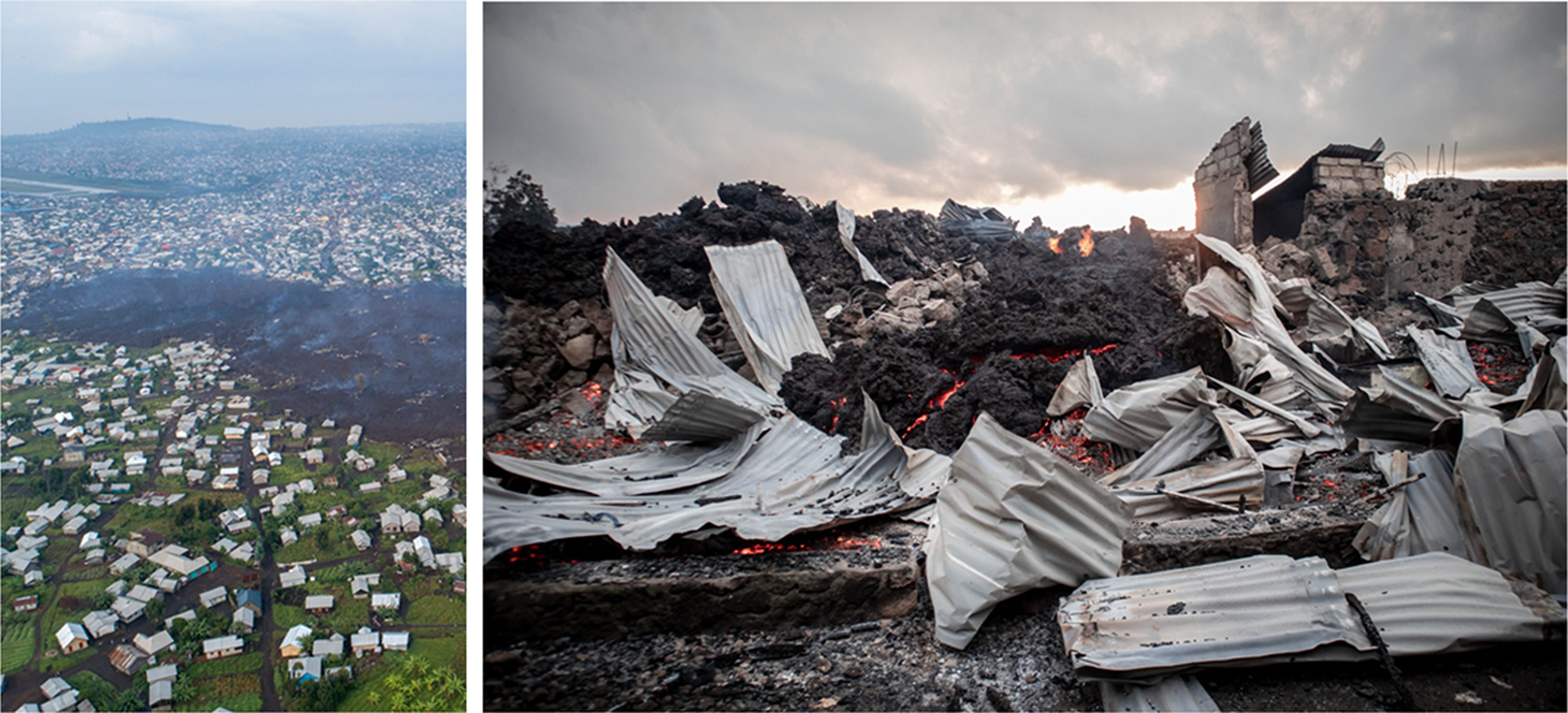
Lava from the May 2021 eruption of Mount Nyiragongo cut through Buhene north of Goma (left) and wrought destruction in a residential district (right). “I saw the red lava pouring down the mountain,” says Goma resident Jean Rwangano. “We saw everything getting destroyed in front of us—our house, the land we used to cultivate.” Images, left to right: © Justin Kabumba/AP; © Guerchom Ndebo, AFP/Getty Images.
“I saw the red lava pouring down the mountain. We saw everything getting destroyed in front of us—our house, the land we used to cultivate,” says Jean Rwangano, an older man whom Ndebo interviewed on the spot where his family’s house once stood. Rwangano also experienced the more devastating 2002 eruption, which killed 70 people and destroyed 120,000 homes in Goma.2 “Then, the lava destroyed our land,” he says, “but our home was spared.”
In the 5 years prior to the 2021 Nyiragongo eruption, volcanic conditions had been worryingly similar to those preceding the 2002 event. A March 2021 news story6 published by Reuters quoted a prescient statement by local volcanologist Honoré Ciraba: “If we don’t do regular measurements and announce the eruption a few days beforehand, the population won’t have time to evacuate, and people will die.” The Goma Volcano Observatory has been struggling for funding, however, making it difficult to perform such measurements.7
Although the threats posed by eruptions like Nyiragongo’s may seem self-evident, the actual health impacts remain understudied. A growing number of scientists are working to change that, researching and comparing notes on both immediate and longer-term effects, of eruptions, from volcanic gas and ash inhalation to impacts on mental health.8
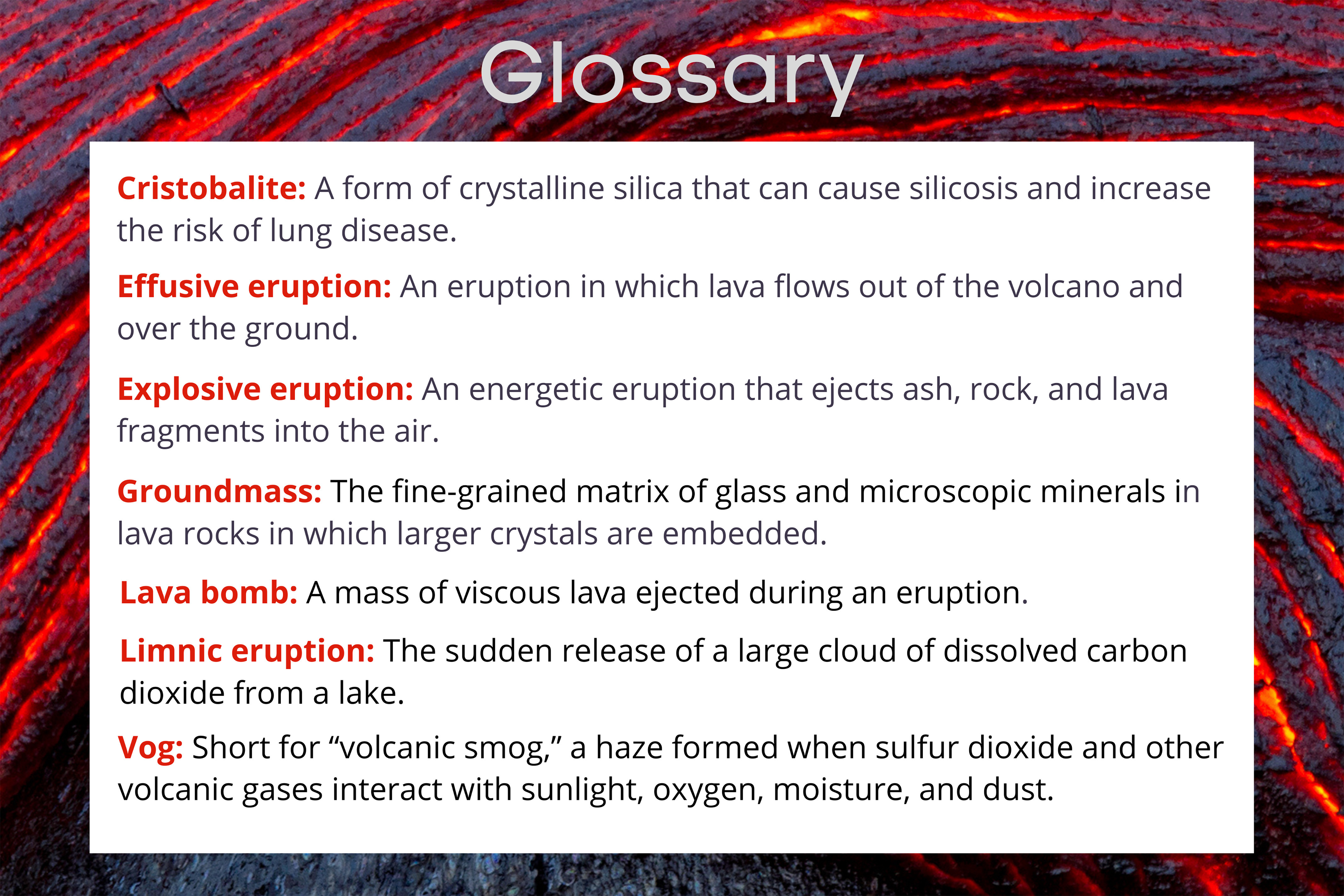
Background image: © iStockphoto/Justinreznick.
Varied Threats from Gases
Volcanoes around the world vary tremendously in terms of how often they erupt and the composition and amount of their emissions. Some lie dormant for decades and then experience a large explosion, like Mount St. Helens in Washington state. Others, like Montserrat’s Soufrière Hills or Kīlauea in Hawai’i, simmer, so to speak, emitting lava, ash, and gases over decades, continuously exposing local populations.
Volcanic emissions include sulfur dioxide (), hydrogen sulfide, hydrogen chloride, and hydrogen fluoride,9 a highly soluble gas that becomes hydrofluoric acid in water and can contaminate water supplies.10,11 exposures following volcanic eruptions have been associated with increased risk of respiratory and cardiovascular illnesses and deaths.12,13,14 High levels of typically occur with so-called effusive eruptions, in which lava flows over the ground, such as the fall 2021 eruption of Cumbre Vieja in the Canary Islands.15 reacts with oxygen and moisture to create a hazy mixture of gas and fine particles called volcanic smog, or vog.16
The emissions hazards at any volcano can change. For example, communities on the Big Island of Hawai’i have lived with vog more or less continuously since the early 1980s, says David Damby, a research scientist for the U.S. Geological Survey (USGS) Volcano Hazard Program. But the huge pulse of ash ejected during the 2018 Kīlauea eruption—the first in almost a century—added a new hazard for residents downwind.
The air around Nyiragongo contains extremely high concentrations of owing to both passive degassing and active eruptions.17,18 In addition to sulfurous gases, carbon dioxide () escapes through fractures on the volcano’s flanks.19 Because it is heavier than oxygen, the gas sinks into low-lying depressions to form pockets of air known as mazuku (“evil winds” in Swahili), which kill livestock and people alike.19 Few studies have examined the human health impact of mazuku, although the phenomenon is well known to local populations.19 Mazuku occurs in other volcanic areas such as Mammoth Mountain in eastern California20 and Mount Amiata in central Italy.21
Gases can also saturate water bodies near volcanoes. Earthquakes and gas saturation of the water are thought to increase the chances of a limnic eruption, in which a cloud of is released from the water. In 1986, a limnic eruption at Cameroon’s Lake Nyos killed approximately 1,700 people.22 Lake Kivu, near Goma, contains the equivalent of 2.6 gigatons of , as well as methane;23 a limnic eruption here would put millions of people at risk.24
A degassing system was engineered and installed on Lake Nyos after the 1986 eruption. The same has been called for on Lake Kivu by the United Nations Environment Program’s Division of Early Warning and Assessment25 and others26 but has not been implemented. Methane harvesting does occur in Lake Kivu in both DRC and neighboring Rwanda, but whether it reduces the chances of a limnic eruption is unclear.27
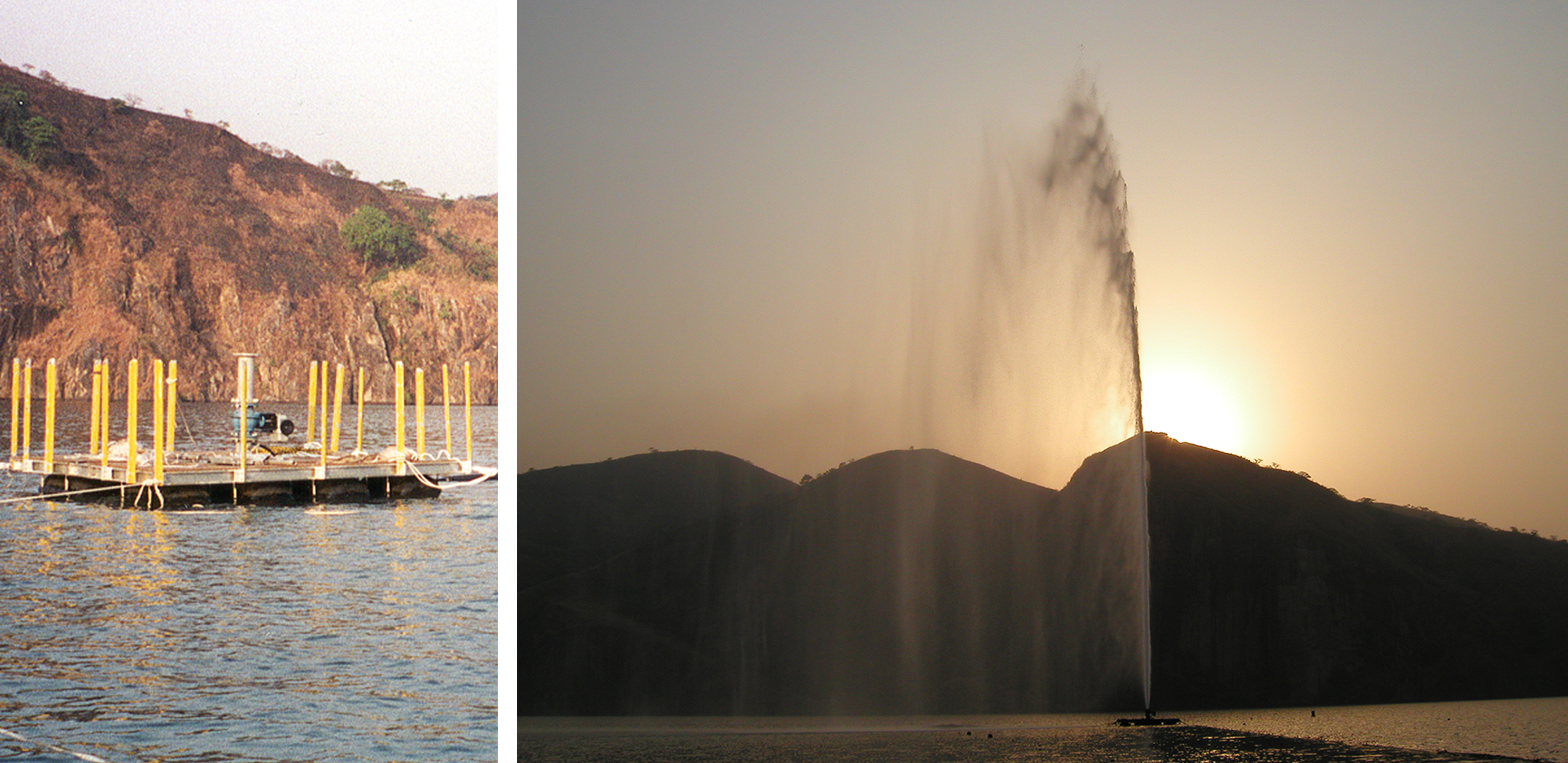
In 1986, Lake Nyos in Cameroon, released a cloud of into the atmosphere in what is known as a limnic eruption. The event killed 1,700 people and 3,500 domestic animals. Engineers installed piping anchored to a raft (left) to artificially remove the gas from the lake to prevent similar disasters in the future. The self-driven fountain (right), which can reach a height of above the lake surface, dissipates the . Both images: Bill Evans/U.S. Geological Survey.
Caroline Michellier, a postdoctoral geography researcher at the Royal Museum for Central Africa in Belgium, says that water contamination from volcanic emissions is potentially more problematic to public health than inhaling ash or gases. Past research on Nyiragongo has documented eruption-related contamination of rainwater—the main source of drinking water for local rural populations—with heavy metals and acidic halogens, including fluoride and chloride.24,28,29 “The water available in the area surrounding the volcano is contaminated by volcanic gas particles due to the permanent plume that can spread over a large distance,” she says. “These particles make the water unsafe to drink.”
Volcanic Ash and Respiratory Disease
The cataclysmic 1980 eruption of Mount St. Helens “was really the first time in modern history that mainland U.S. was affected by an eruption,” says Claire Horwell, a professor of geohealth at Durham University in England and founder of the International Volcanic Health Hazard Network (IVHHN). “Huge resources were poured into trying to understand its impact on the community.”
Researchers immediately started examining the composition of the tons of ash the volcano spewed as it erupted.30 “The ash contained a mineral called crystalline silica. Given that industrial exposures to mineral dusts cause diseases like silicosis and lung cancer,31 there was immediate concern that volcanic crystalline silica could also cause these diseases.32
Toxicologists tested the pulmonary effects of the ash using cells and rodents, with mixed results.33,34 Other researchers launched epidemiological studies, particularly on loggers, who had high occupational exposures to ash from Mount St. Helens.35,36 In 1995, while scientists were still studying the longer-term impacts of ash from Mount St. Helens, Soufrière Hills began a series of eruptions, expelling ash that also had high crystalline silica content.37 Damby says this event also triggered sustained interest and investment in understanding the health impacts of eruptions.
“What’s clear about ash exposure is that hospital admittances for acute health issues—asthma, bronchitis, etc.38,39—often increase following an eruption,” says Damby. For long-term health impacts,40,41 “there is insufficient data to even begin drawing a conclusion, but it is a tremendously important question because of the number of people that live near volcanoes globally.” He adds, “The high variability in ash properties makes this a particularly difficult question. … [P]articulate matter in the air generally increases morbidity and mortality,42 but whether volcanic ash falls under this same conclusion, we are working to determine.”
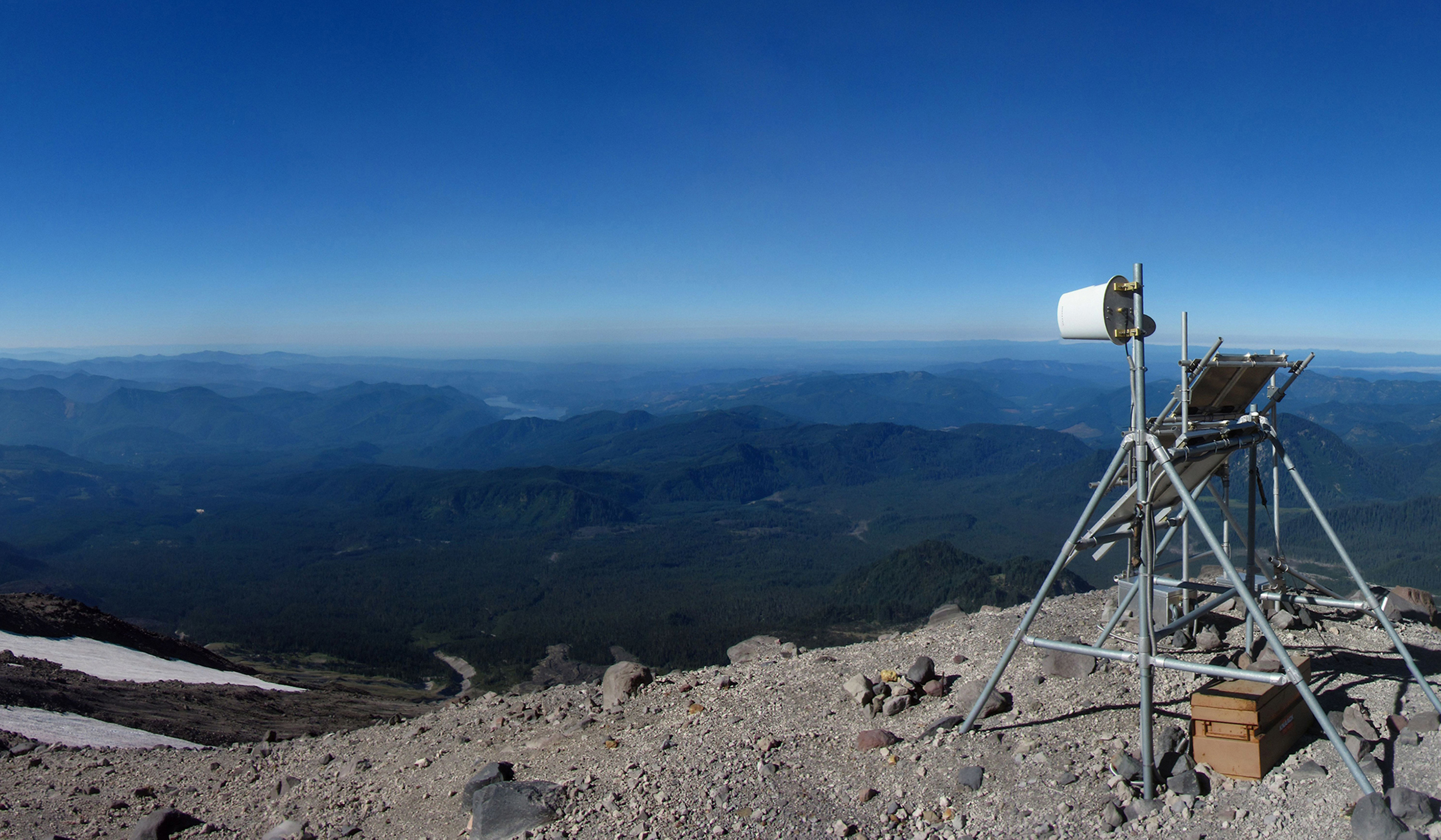
Scientists rely on remote monitoring equipment, like this station on the southwest flank of Mount St. Helens, to monitor volcanic activity. These monitors deliver real-time data around the clock. Volcano monitoring stations integrate many instruments into a single package to lower power requirements, reduce instrument footprint on sensitive landscapes, enable rapid deployment, and transmit data effectively under extreme weather conditions. Image: U.S. Geological Survey.
The good news is that so far it looks as if certain properties of the ash may attenuate potentially harmful, long-term health impacts. Take the example of crystalline silica, which is classified as a known human carcinogen by the International Agency for Research on Cancer (IARC).43 Horwell and Damby’s research has shown crystalline silica may be less harmful in volcanic environments than in some other settings. And in fact, when the IARC classified the substance as a carcinogen in 1997,43 the agency elaborated that its level of toxicity depends on both inherent characteristics of the silica and external factors. This is known as the crystalline silica enigma.44 Damby, Horwell, and colleagues set out to define these factors for volcanic crystalline silica.
The researchers found that the structure of the cristobalite (a form of crystalline silica) in volcanic ash was often impure. “The chemical structure should be just silicon dioxide, but we found that the silicon was often substituted with aluminum in small quantities. Aluminum is known to ameliorate crystalline silica toxicity,” Horwell explains. “We then tested if toxicity of crystalline silica was actually affected by these impurities in a simulated laboratory experiment and found that, indeed, the cytotoxicity was dampened when cristobalite was doped with aluminum and sodium impurities.”45
The researchers also found that individual cristobalite particles rarely occurred in ash. Instead, the cristobalite was usually embedded in the groundmass,46 the fine-grained base of volcanic rock in which larger crystals are embedded. “So, when the ash interacts with cellular components in the lung, the ash particle surface that the cells interact with may be composed of less toxic volcanic components … rather than cristobalite,” Horwell says.
Nevertheless, Horwell and Damby acknowledge that the absence of a link does not exclude it. “Chronic respiratory diseases can take a long time to manifest, and through to the mid-2000s only a few eruptions had been studied,” says Damby.
How exposure to the volcanic cocktail of ash and gases affects individuals with preexisting health conditions and vulnerabilities—something unfortunately common near Nyiragongo—is also not yet clear. Patrick Katoto, deputy-director of the Center for Tropical Disease and Global Health at DRC’s Catholic University of Bukavu, studies the intersection of the region’s volcanic emissions and its high rates of endemic diseases, such as HIV/tuberculosis co-infection and cholera. “I’m trying to see the interaction between the endemic diseases and emerging risk factors, like household air pollution and volcanic gas exposure,” he says.
Mining activities, which are common in the Kivu region around Nyiragongo and Nyamuragira, potentially complicate health risks.47 “We know that gold mining is associated with increased production of dust and, of course, an increase in silica dust exposure, which is associated with high risk of getting silicosis. And we know that if you have silicosis, your risk of getting tuberculosis is [much greater48],” Katoto explains. “We also know that from volcanic ash, you can also have silica dust. What we don’t know is if silica dust is related to the high prevalence of tuberculosis in Goma.”
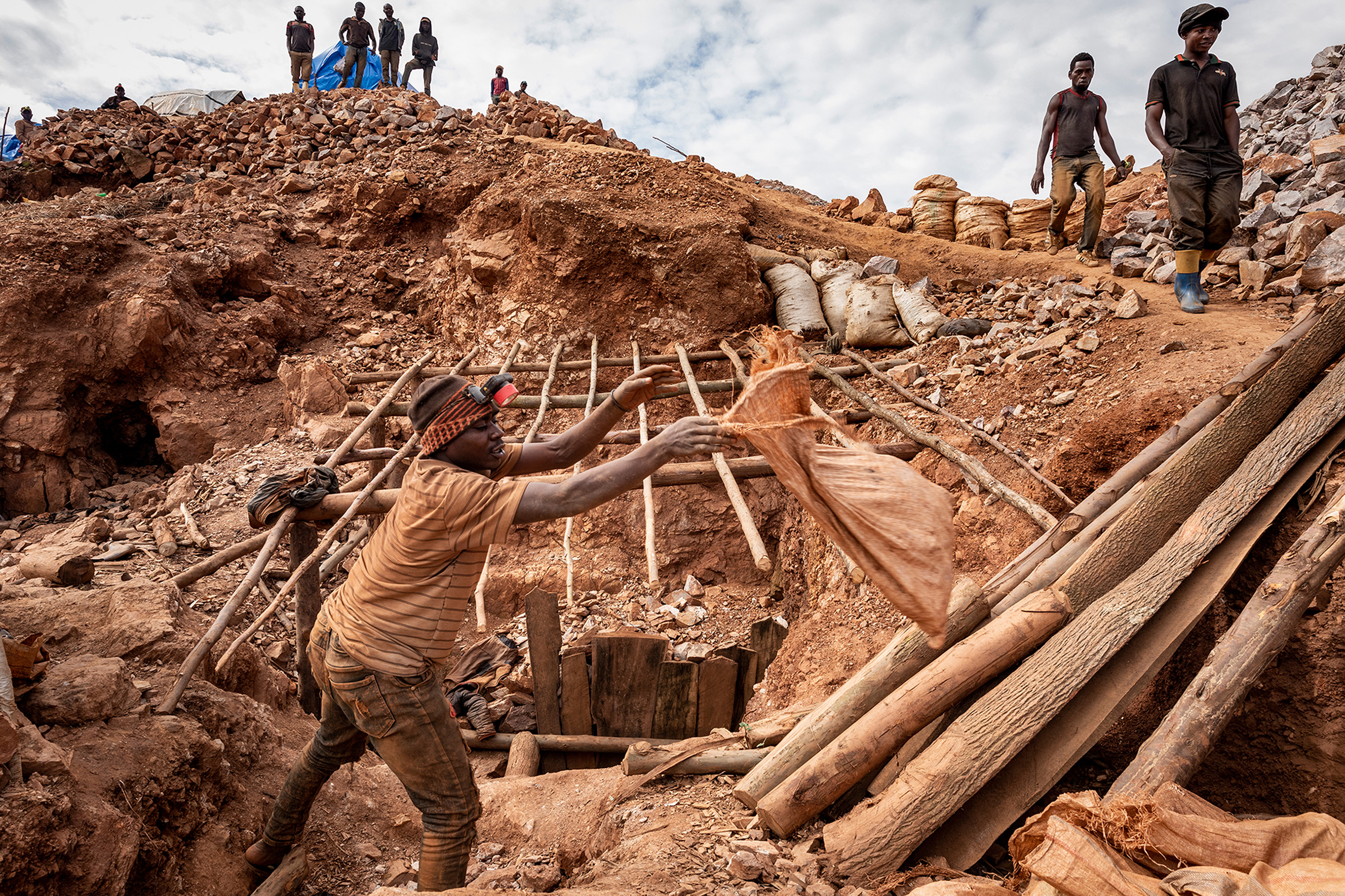
Research is ongoing to determine whether underlying disease may be exacerbated by exposure to volcanic ash. Working in informal gold mines like this site in Bukavu, South Kivu, predisposes workers to silicosis and increases risk of tuberculosis. “What we don’t know is if volcanic silica dust is related to the high prevalence of tuberculosis in Goma,” says Patrick Katoto. Image: © Patrick Brown, UNICEF/Panos Pictures.
Katoto and others did link exposure to the region’s high levels of to risk of acute respiratory symptoms, with caveats.49 They looked at people visiting health centers at various distances from Nyiragongo. “We found that the association was quite remarkable when people were very close to the volcano [within ], but we didn’t find that independent effect when we’re far from the volcano,” he says. “We didn’t find a monotonic pattern.” He adds that this could be due to confounding factors.
Disruption, Displacement, and Terror
Displacement as a result of a volcanic eruption comes with its own health concerns. A massive, unexpected displacement of people can lead to preventable disease outbreaks,50 and temporary shelters are ripe for waterborne diseases related to lack of clean drinking water and sanitation. “In an eruption, by far the greatest concern for those that are not in immediate danger from the eruption is the impact to WASH [water, sanitation, and hygiene] and to their food supplies and the effects of living in shelters,” says Horwell. Damby adds, “Making sure people have safe drinking water—especially in Goma, where cholera is endemic—is going to take priority over emissions.”
Although major disease outbreaks have thus far been avoided since the eruption of Nyiragongo and subsequent evacuation, living conditions in refugee camps remain dire.4 Reports of overcrowding, unhygienic conditions, violence, and desperation in these camps continue.4 As of February 2022, thousands of people remained displaced.51 Yet many of the humanitarian efforts undertaken after the eruption were funded only for 6 months; these ended in December.51
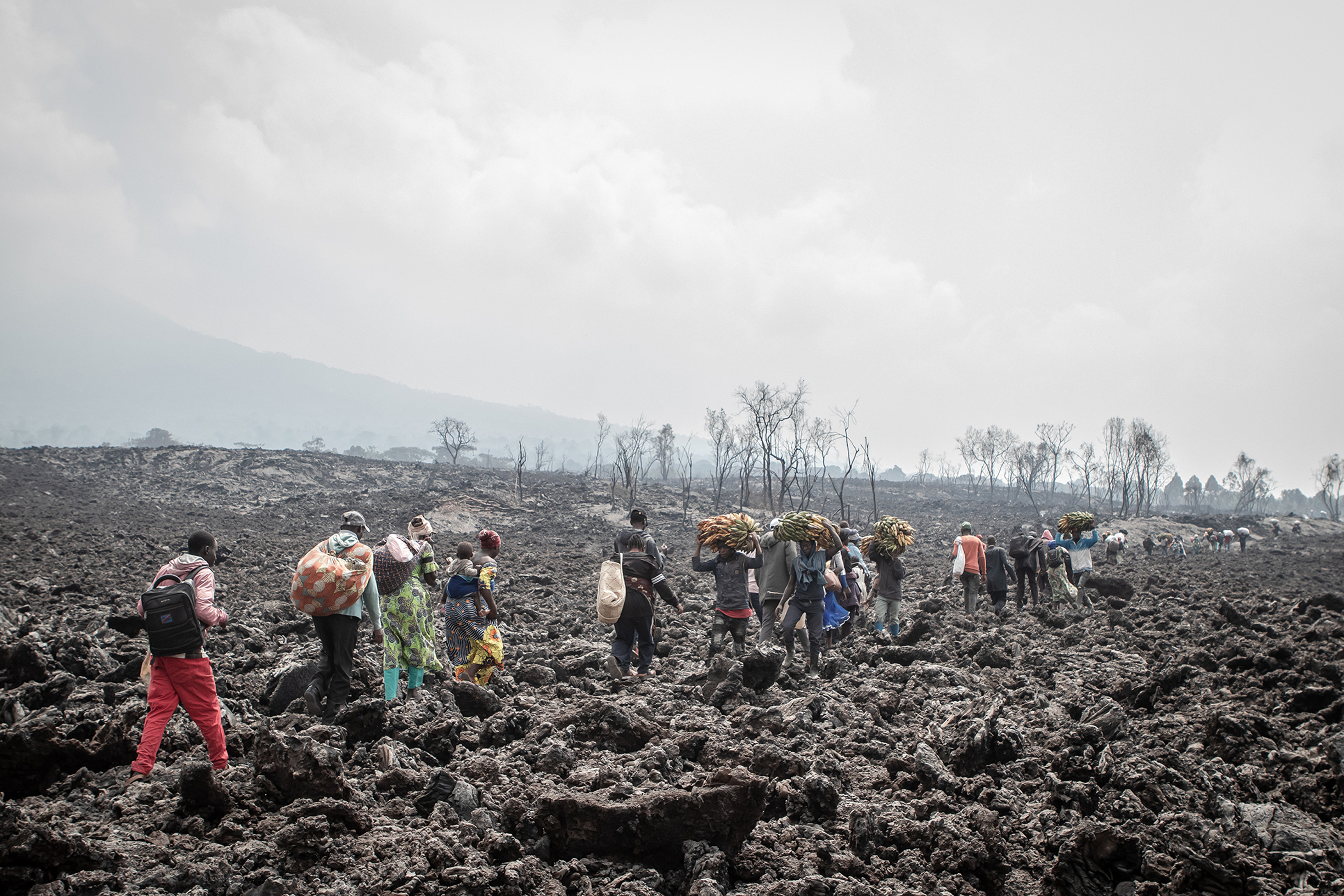
On 25 May 2021, Goma residents displaced by the eruption of Mount Nyiragongo walked through the cooled lava in search of a safe place. Some carried goods to the city’s market. The psychological and economic impacts of displacement can linger long after an eruption occurs. Image: © Guerchom Ndebo.
Less visibly, psychological trauma also affects those who have witnessed death, injury, and destruction, as well as those who are themselves injured or displaced from their homes.52,53,54 This was evident after the Nyiragongo eruption.
“The hospitals were full of people coming for everything: coughing, vomiting, PTSD [post-traumatic stress disorder],” says Katoto. “You can’t quantify the prevalence of PTSD, but you can imagine that it will have consequences, especially in a city where people are stressed by civil unrest.”
In May 2020, the DRC Parliament had declared a state of siege for the province where Nyiragongo is located, purportedly to stop civilian massacres by guerilla groups fighting over control of mineral resources.55,56 Since the eruption, armed groups have terrorized displaced residents with kidnappings, physical and psychological assault, rape, and other crimes, according to reports from the United Nations High Commissioner for Refugees.4
In other areas, ongoing eruptions become a way of life. People may normalize the exposures, which could lead them to protect their health to a lesser extent. One time, Horwell was a few kilometers from Soufrière Hills when a dome collapse occurred—a slope buckled under pressure, sending large amounts of pyroclastic materials down the volcano and filling the sky with a low, dark ash cloud. “I was in my vehicle and suddenly it was pitch black,” says Horwell. “I knew from my training that it was ash and small bits of pumice, but it was still a very scary experience to just turn off the engine in the middle of the road and sit there in absolute blackness with this stuff coming down on the roof until it was finished.”
The experience opened her eyes to what the locals went through on a regular basis, since there were frequent explosions and dome collapses on Montserrat at that time. “Once it became light again, I could see that there were people in the village all around me, who just sat there, covered in ash,” Horwell says. “It was interesting to see how people can normalize a situation and it becomes their daily life rather than a crisis.”
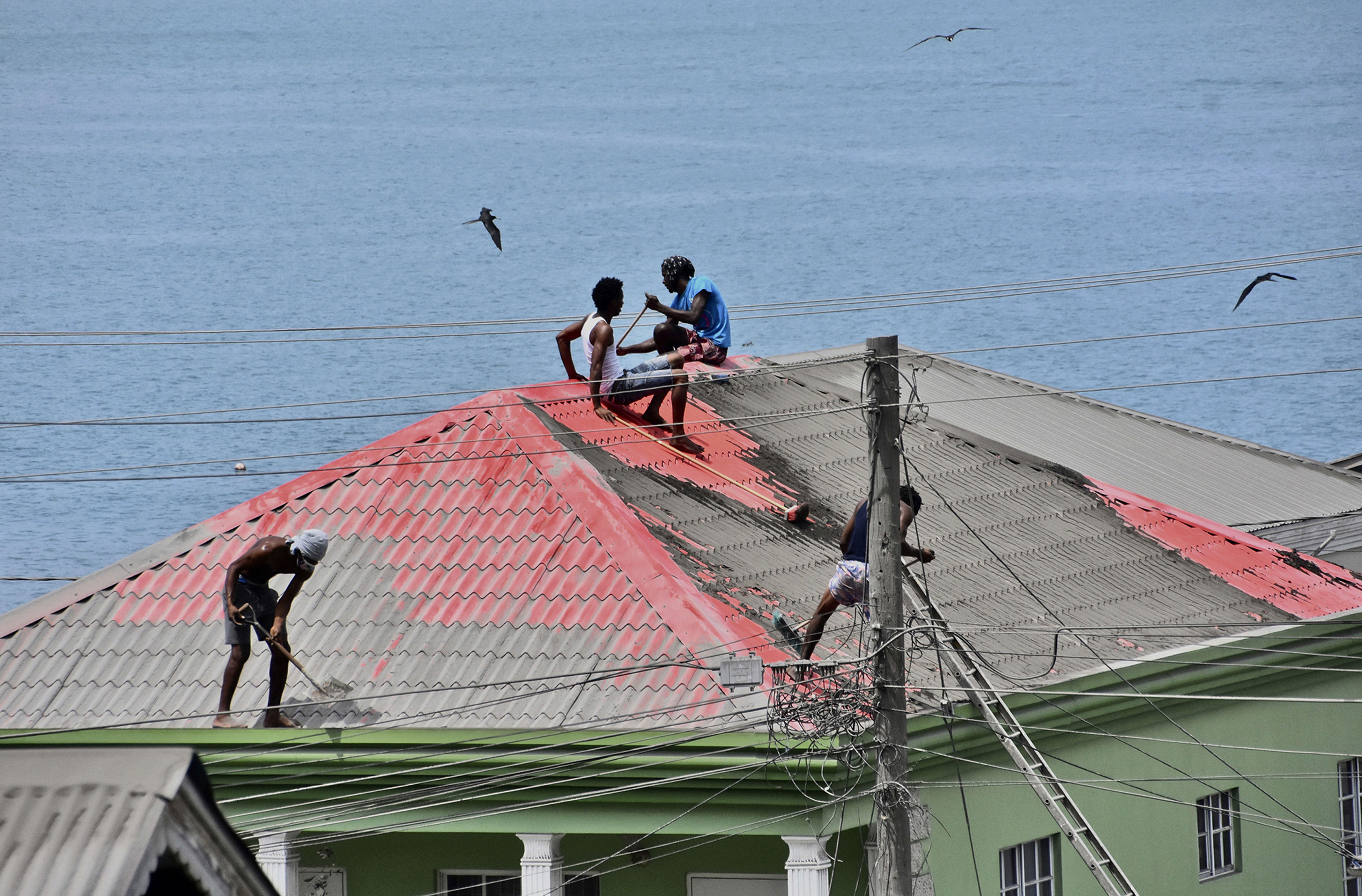
In this April 2021 photo, after an eruption of Soufrière Hills, people cleaned volcanic ash from the red roof of a home in Wallilabou, on the western side of the Caribbean island of St. Vincent. Of her time studying Soufrière Hills, Horwell was struck by “how people can normalize a situation and it becomes their daily life rather than a crisis.” Image: © Orvil Samuel/AP.
Preventing the Worst Consequences of Disaster
Planning for disasters and establishing local expertise can prevent or minimize the many consequences of volcanic eruptions, including loss of life, psychological trauma, disease outbreaks, and more. In one such effort, IVHHN is working to create an organization of experts available during eruption crises. It offers an online hub for evidence-based information on volcanic impacts on health and guidance for responding to emergencies.
The idea for IVHHN had its roots in the 1980 eruption of Mount St. Helens. Those who responded to the event realized early that a coordinated, multiagency effort was needed, drawing on scientists and practitioners from a wide range of disciplines. “A large number of people became involved in research, but there was no network to bring their expertise together. And then the eruption finished, and people went back to their day jobs,” says Horwell.
During Horwell’s later graduate research on Soufrière Hills, she talked to people in various disciplines: toxicologists, medics, public health specialists, chemists, environmental scientists, and geologists. “I was building a network around me, and it became clear to me that this should be more formalized.” With support from her advisor, Steve Sparks, she created IVHHN in 2003.
“The network aims to make as much information as accessible in as many languages and through as many channels as possible, so that people have actionable information during a volcanic crisis,” says Damby, who with Horwell is one of four codirectors of IVHHN. Although most volcanologists know of the network, many local health agencies do not. IVHHN researchers are raising awareness of their knowledge bank at the local level so emergency managers and others can tap into the network’s expertise.
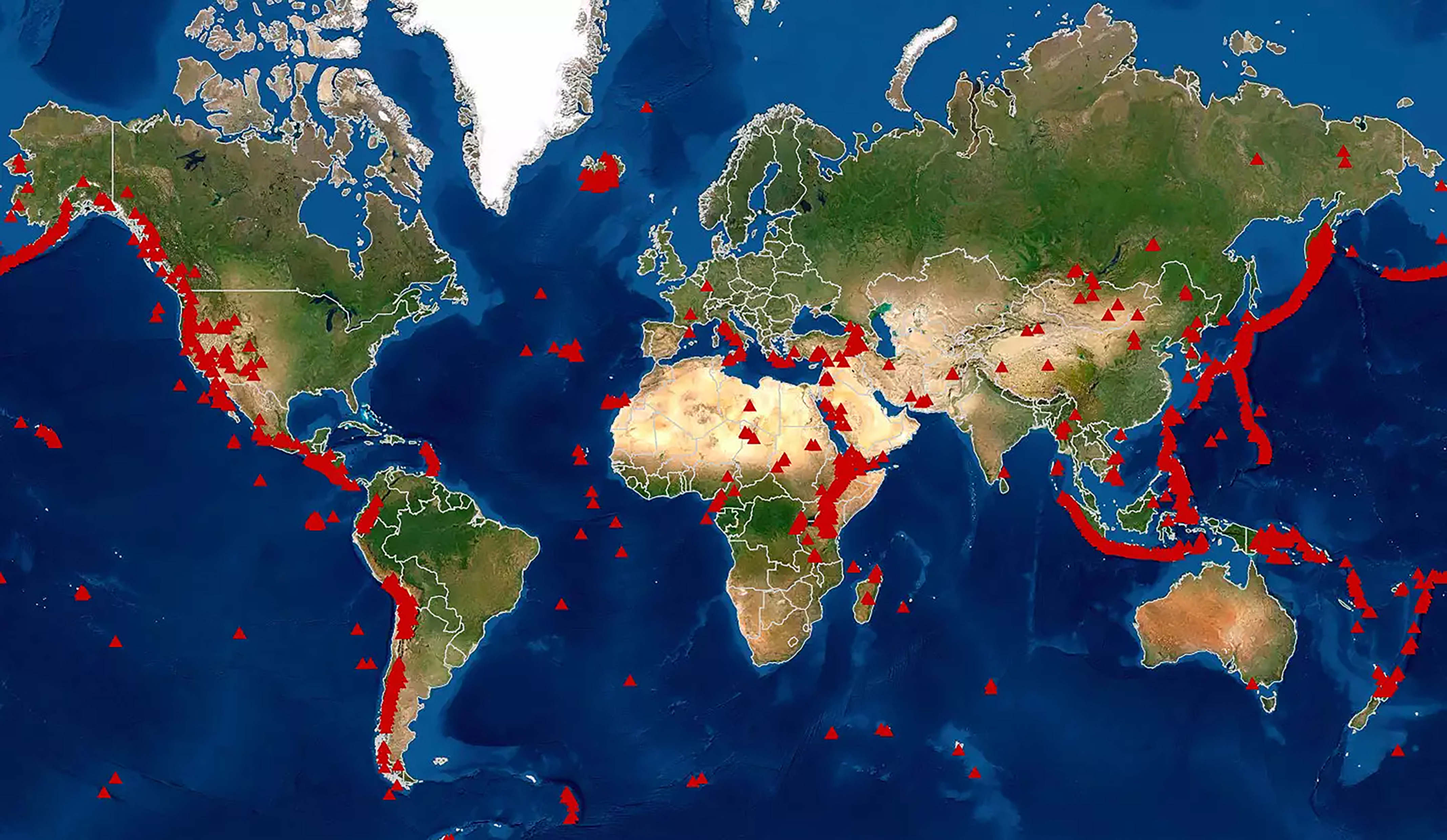
Red triangles mark locations of active volcanoes across the world. In 2015, more than people were estimated to live within of a volcano, a distance within which they could potentially experience direct impacts of an eruption.62 Image: Worldinmaps.com
Meanwhile, the Center for the Study of Active Volcanoes (CSAV) in Hilo, Hawai’i, runs an international training program to provide low- and middle-income countries with local capacity to manage volcano hazards. The center was created after the disastrous 1985 eruption of Colombia’s Nevado del Ruiz. “It was pretty well known the volcano was building to an eruption, but Colombia simply didn’t have the [capacity] to make decisions on evacuating the population,” says center director Don Thomas. “The end result was that 23,000 people were killed by a relatively small eruption and one where the deaths were entirely preventable.57 Everyone that was killed could have walked to safety if they knew what to do.”
The Volcano Disaster Assistance Program, a partnership between the U.S. Agency for International Development and USGS, often provides instructors for CSAV courses. “We’ve held classes since 1990 where we bring folks in, predominantly from developing countries, and provide them with training on a full spectrum of methods for checking the pulse of an active volcano,” says Thomas. This training can help save lives as well as reduce exposures and health risks.
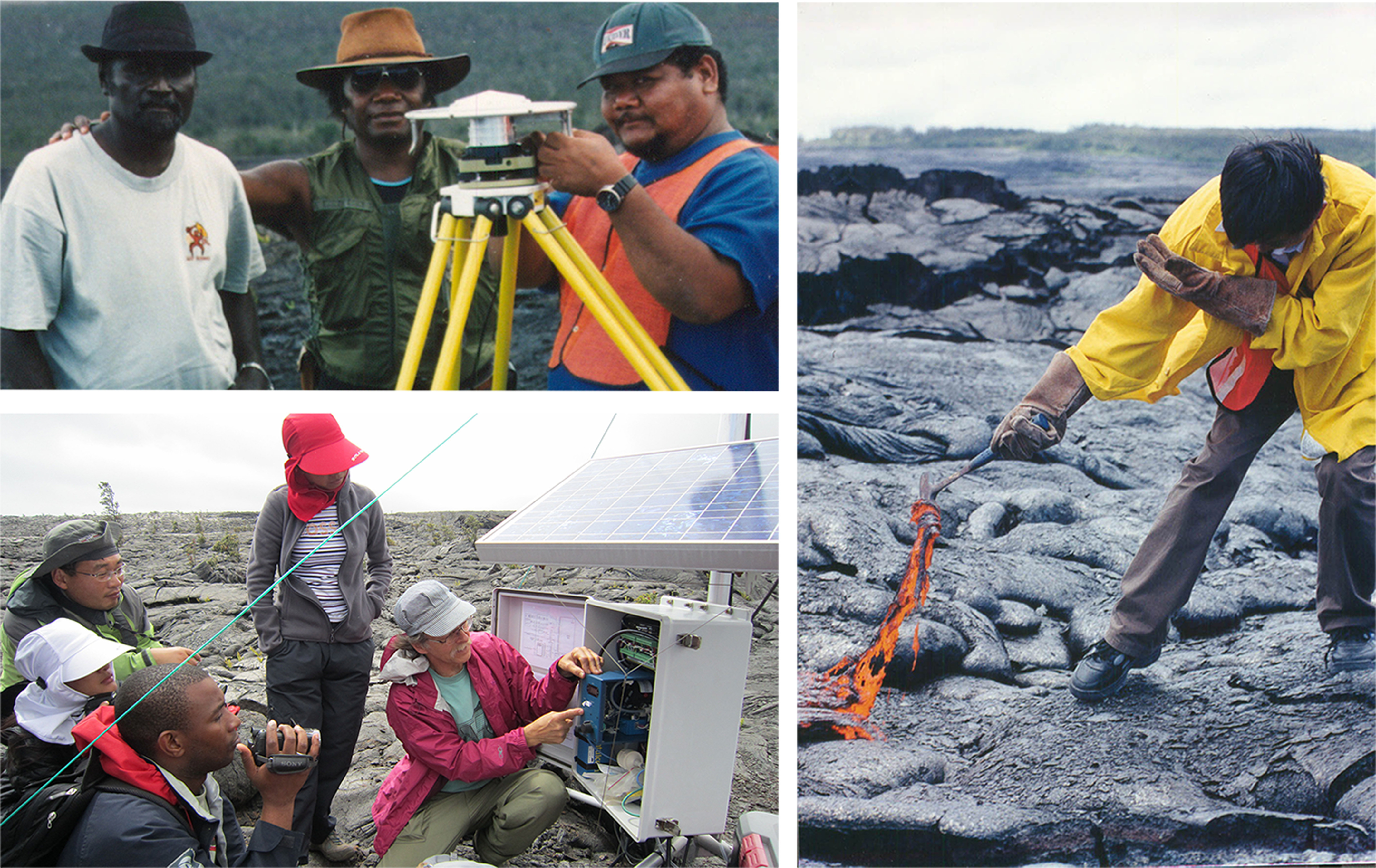
The CSAV international training program provides low- and middle-income countries with local expertise for managing volcano hazards. Top left: trainees from the Solomon Islands, Vanuatu, and the Marianas Islands set up a Global Positioning System receiver. Bottom left: Jeff Sutton of the Hawai’i Volcano Observatory explains how a continuous gas sampling monitor works. Right: A trainee from China samples molten lava. All images: Center for the Study of Active Volcanoes.
From Nyiragongo to Kīlauea, Soufrière Hills, and beyond, scientists continue to study the impacts of volcanoes on human health, eruption by eruption, so their impacts can be understood and minimized. Volcanic threats to human livelihood, health, and life—not to mention climate and the economy—have the potential to be globally catastrophic. For instance, the 1815 eruption of Tambora in Indonesia—the biggest eruption in recorded history—had such a profound impact on climate worldwide that it led to the “Year Without a Summer” in 1816 due to volcanic ash and aerosols blocking the sun.58
“[Tambora] pumped a lot of sulfur into the stratosphere, and that changed the climate. There were frosts in New England in June, crops were destroyed and damaged. The growing season was short on both sides of the Atlantic,” explains University of Cambridge volcanologist Clive Oppenheimer. “There’s a pretty credible argument linking that eruption to the food crisis and outbreaks of typhus in Ireland.”
Even moderate eruptions can cause economic disruption. For example, when Iceland’s Eyjafjallajökull erupted in 2010, the ash traveled unusually far for an event of its size.59 Travel and trade disruptions cost the global economy an estimated in the first week alone.60
To some, volcanic eruptions may seem like isolated news events far away. However, a large eruption like Tambora will eventually happen again, potentially disrupting climate and causing food crises and disease outbreaks far away. The January 2022 eruption of Hunga-Tonga-Hunga-Ha’apai in the Tongan archipelago literally sent shock waves around the world;61 the impacts of this event are still unfolding. More importantly, though, even “typical” eruptions have a major impact on the populations nearby. And while living with the clear and present danger of a volcanic eruption is a way of life for some communities, like those near Nyiragongo, supporting resiliency efforts for these communities can help reduce harmful impacts when volcanoes do erupt. That goes not only for people in the path of danger but also for those around the world who may someday be affected.
Biography
Wendee Nicole is an award-winning science writer in Houston. She has written for Discover, Defenders of Wildlife, and other publications. The article was reported with assistance from Guerchom Ndebo, a Goma-based photojournalist.
References
- 1.Tazieff H, Bichet P, 1979. Nyiragongo, The Forbidden Volcano. New York, NY: Barrons/Woodbury. [Google Scholar]
- 2.Baxter PJ, Ancia A. 2002. Human Health and Vulnerability in the Nyiragongo Volcano Crisis: Democratic Republic of Congo, 2002—Final Report to the World Health Organisation. Geneva, Switzerland: World Health Organization. https://apps.who.int/iris/bitstream/handle/10665/69258/a88434_eng.pdf?sequence=1&isAllowed=y [accessed 21 January 2022]. [Google Scholar]
- 3.Morrison A, Whittington A, Smets B, Kervyn M, Sehlke A. 2020. The rheology of crystallizing basaltic lavas from Nyiragongo and Nyamuragira volcanoes, D.R.C. Volcanica 3(1):1–28, 10.30909/vol.03.01.0128. [DOI] [Google Scholar]
- 4.United Nations High Commissioner for Refugees. 2021. Emergency Update on Volcano Nyiragongo #7. 5 November 2021. https://data2.unhcr.org/en/documents/details/89478 [accessed 21 January 2022].
- 5.United Nations High Commissioner for Refugees. 2021. Emergency Update on Volcano Nyiragongo #1. 31 May 2021. https://data2.unhcr.org/en/documents/details/87007 [accessed 21 January 2022].
- 6.Holland H. 2021. Rising magma and empty coffers raise alarm for Congo’s volcano-watchers. Reuters, Environment section, 10 March 2021. https://www.reuters.com/business/environment/rising-magma-empty-coffers-raise-alarm-congos-volcano-watchers-2021-03-10/ [accessed 21 January 2022].
- 7.Neiman S. 2021. Underpaid and under fire: the risky business of monitoring Congo’s volatile volcano. The New Humanitarian, Environment and Disasters section, 16 September 2021. https://www.thenewhumanitarian.org/news-feature/2021/11/22/funding-gaps-risky-business-monitoring-Congo-volcano-eruption [accessed 21 January 2022].
- 8.Hansell AL, Horwell CJ, Oppenheimer C. 2006. The health hazards of volcanoes and geothermal areas. Occup Environ Med 63(2):149–156, PMID: , 10.1136/oem.2005.022459. [DOI] [PMC free article] [PubMed] [Google Scholar]
- 9.McGee KA, Doukas MP, Kessler R, Gerlach TM. 1997. Impacts of Volcanic Gases on Climate, the Environment, and People. U.S. Geological Survey Open-File Report 97-262. Vancouver, WA: U.S. Geological Survey. https://pubs.usgs.gov/of/1997/of97-262/of97-262.html [accessed 21 January 2022]. [Google Scholar]
- 10.Cuoco E, Spagnuolo A, Balagizi C, De Francesco S, Tassi F, Vaselli O, et al. 2013. Impact of volcanic emissions on rainwater chemistry: the case of Mt. Nyiragongo in the Virunga volcanic region (DRC). J Geochem Explor 125:69–79, 10.1016/j.gexplo.2012.11.008. [DOI] [Google Scholar]
- 11.Williams-Jones G, Rymer H. 2015. Chapter 57: Hazards of volcanic gases. In: The Encyclopedia of Volcanoes. 2nd ed. Sigurdsson H, Houghton B, McNutt SR, Rymer H, Stix J, eds. New York, NY: Academic Press, 985–992. [Google Scholar]
- 12.Carlsen HK, Valdimarsdóttir U, Briem H, Dominici F, Finnbjornsdottir RG, Jóhannsson T, et al. 2021. Severe volcanic SO2 exposure and respiratory morbidity in the icelandic population—a register study. Environ Health 20(1):23, PMID: , 10.1186/s12940-021-00698-y. [DOI] [PMC free article] [PubMed] [Google Scholar]
- 13.Venners SA, Wang B, Xu Z, Schlatter Y, Wang L, Xu X. 2003. Particulate matter, sulfur dioxide, and daily mortality in Chongqing, China. Environ Health Perspect 111(4):562–567, PMID: , 10.1289/ehp.5664. [DOI] [PMC free article] [PubMed] [Google Scholar]
- 14.Heaviside C, Witham C, Vardoulakis S. 2021. Potential health impacts from sulfur dioxide and sulphate exposure in the UK resulting from an icelandic effusive volcanic eruption. Sci Total Environ 774:145549, PMID: , 10.1016/j.scitotenv.2021.145549. [DOI] [PubMed] [Google Scholar]
- 15.Voiland A. 2021. Sulfur skies over La Palma. Greenbelt, MA: NASA Earth Observatory, 18 October 2021. https://earthobservatory.nasa.gov/images/148978/sulfur-skies-over-la-palma [accessed 21 January 2022]. [Google Scholar]
- 16.International Volcanic Health Hazard Network. 2021. What Is Vog? Updated January 2021. https://vog.ivhhn.org/what-vog [accessed 21 January 2022].
- 17.Global Volcanism Program. 2020. Report on Nyiragongo (DR Congo). Bull Global Volcanism Network 45(12). 10.5479/si.GVP.BGVN202012-223030. [DOI] [Google Scholar]
- 18.Carn SA. 2003. Eruptive and passive degassing of sulfur dioxide at Nyiragongo volcano (D.R.Congo): the 17th January 2002 eruption and its aftermath. Acta Vulcanologica 14–15(1–2):75–86. [Google Scholar]
- 19.Smets B, Tedesco D, Kervyn F, Kies A, Vaselli O, Yalire MM. 2010. Dry gas vents (“mazuku”) in Goma region (North-Kivu, Democratic Republic of Congo): formation and risk assessment. J African Earth Sci 58(5):787–798, 10.1016/j.jafrearsci.2010.04.008. [DOI] [Google Scholar]
- 20.Hill PM. 2000. Possible asphyxiation from carbon dioxide of a cross-country skier in eastern California: a deadly volcanic hazard. Wilderness Environ Med 11(3):192–195, PMID: , 10.1580/1080-6032(2000)011[0192:pafcdo]2.3.co;2. [DOI] [PubMed] [Google Scholar]
- 21.Tassi F, Vaselli O, Cuccoli F, Buccianti A, Nisi B, Lognoli E, et al. 2009. A geochemical multi-methodological approach in hazard assessment of CO2-rich gas emissions at Mt. Amiata Volcano (Tuscany, Central Italy). Water Air Soil Pollut Focus 9(1–2):117–127, 10.1007/s11267-008-9198-2. [DOI] [Google Scholar]
- 22.Baxter PJ, Kapila M, Mfonfu D. 1989. Lake Nyos disaster, Cameroon, 1986: the medical effects of large scale emission of carbon dioxide? BMJ 298(6685):1437–1441, PMID: , 10.1136/bmj.298.6685.1437. [DOI] [PMC free article] [PubMed] [Google Scholar]
- 23.Jones N. 2021. How dangerous is Africa’s explosive Lake Kivu? Nature 597(7877):466–469, PMID: , 10.1038/d41586-021-02523-5. [DOI] [PubMed] [Google Scholar]
- 24.Balagizi CM, Kies A, Kasereka MM, Tedesco D, Yalire MM, McCausland WA. 2018. Natural hazards in Goma and the surrounding villages, East African Rift system. Nat Hazards 93(1):31–66, 10.1007/s11069-018-3288-x. [DOI] [Google Scholar]
- 25.IRIN News. 2007. Lake Kivu—a time bomb or source of energy? The New Humanitarian, Environment and Disasters section, 15 August 2007. https://www.thenewhumanitarian.org/report/73738/drc-lake-kivu-–-time-bomb-or-source-energy [accessed 21 January 2022].
- 26.Kling GW, Evans WC, Tanyileke G, Kusakabe M, Ohba T, Yoshida Y, et al. 2005. Degassing Lakes Nyos and Monoun: defusing certain disaster. Proc Natl Acad Sci USA 102(40):14185–14190, PMID: , 10.1073/pnas.0502274102. [DOI] [PMC free article] [PubMed] [Google Scholar]
- 27.Bolson N, Yutkin M, Patzek T. 2021. Energy efficiency and sustainability assessment for methane harvesting from Lake Kivu. Energy 225:120215, 10.1016/j.energy.2021.120215. [DOI] [Google Scholar]
- 28.Cuoco E, Tedesco D, Poreda RJ, Williams JC, De Francesco S, Balagizi C, et al. 2013. Impact of volcanic plume emissions on rain water chemistry during the January 2010 Nyamuragira eruptive event: implications for essential potable water resources. J Hazard Mater 244–245:570–581, PMID: , 10.1016/j.jhazmat.2012.10.055. [DOI] [PubMed] [Google Scholar]
- 29.Kasereka MM, Cuoco E, Zabene FZ, Balagizi CM. 2021. Baseline for rainwater chemistry and quality as influenced by Nyiragongo volcano permanent plume, East Africa. Chemosphere 283(1):130859, PMID: , 10.1016/j.chemosphere.2021.130859. [DOI] [PubMed] [Google Scholar]
- 30.USGS (U.S. Geological Survey). n.d. Mount Saint Helens FAQs. https://www.usgs.gov/volcanoes/mount-st.-helens/science/faqs [accessed 21 January 2022].
- 31.Sato T, Shimosato T, Klinman DM. 2018. Silicosis and lung cancer: current perspectives. Lung Cancer (Auckl) 9:91–101, PMID: , 10.2147/LCTT.S156376. [DOI] [PMC free article] [PubMed] [Google Scholar]
- 32.Green FH, Vallyathan V, Mentnech MS, Tucker JH, Merchant JA, Kiessling PJ, et al. 1981. Is volcanic ash a pneumoconiosis risk? Nature 293(5829):216–217, PMID: , 10.1038/293216a0. [DOI] [PubMed] [Google Scholar]
- 33.Martin TR, Wehner AP, Butler J. 1983. Pulmonary toxicity of Mt. St. Helens volcanic ash. Am Rev Respir Dis 128(1):158–162, PMID: , 10.1164/arrd.1983.128.1.158. [DOI] [PubMed] [Google Scholar]
- 34.Beck BD, Brain JD, Bohannon JE. 1981. The pulmonary toxicity of an ash sample from the Mt. St. Helens volcano. Exp Lung Res 2(4):289–301, PMID: , 10.3109/01902148109052324. [DOI] [PubMed] [Google Scholar]
- 35.Merchant JA, Baxter P, Bernstein R, McCawley M, Falk H, Stein G, et al. 1982. Health implications of the Mount St. Helens’ eruption: epidemiological considerations. Ann Occup Hyg 26(8):911–919, 10.1093/annhyg/26.8.911. [DOI] [PubMed] [Google Scholar]
- 36.Bernstein RS, Baxter PJ, Falk H, Ing R, Foster L, Frost F. 1986. Immediate public health concerns and actions in volcanic eruptions: lessons from the Mount St. Helens eruptions, May 18–October 18, 1980. Am J Public Health 76(3 suppl):25–37, PMID: , 10.2105/ajph.76.suppl.25. [DOI] [PMC free article] [PubMed] [Google Scholar]
- 37.Baxter PJ, Bonadonna C, Dupree R, Hards VL, Kohn SC, Murphy MD, et al. 1999. Cristobalite in volcanic ash of the Soufriere Hills volcano, Montserrat, British West Indies. Science 283(5405):1142–1145, PMID: , 10.1126/science.283.5405.1142. [DOI] [PubMed] [Google Scholar]
- 38.Horwell CJ, Baxter PJ. 2006. The respiratory health hazards of volcanic ash: a review for volcanic risk mitigation. Bull Volcanol 69(1):1–24, 10.1007/s00445-006-0052-y. [DOI] [Google Scholar]
- 39.Carlsen HK, Ilyinskaya E, Baxter PJ, Schmidt A, Thorsteinsson T, Pfeffer MA, et al. 2021. Increased respiratory morbidity associated with exposure to a mature volcanic plume from a large Icelandic fissure eruption. Nat Commun 12(1):2161, PMID: , 10.1038/s41467-021-22432-5. [DOI] [PMC free article] [PubMed] [Google Scholar]
- 40.Tam E, Miike R, Labrenz S, Sutton AJ, Elias T, Davis J, et al. 2016. Volcanic air pollution over the island of Hawai’i: emissions, dispersal, and composition. Association with respiratory symptoms and lung function in Hawai’i Island school children. Environ Int 92–93:543–552, PMID: , 10.1016/j.envint.2016.03.025. [DOI] [PMC free article] [PubMed] [Google Scholar]
- 41.Mueller W, Cowie H, Horwell CJ, Hurley F, Baxter PJ. 2020. Health impact assessment of volcanic ash inhalation: a comparison with outdoor air pollution methods. Geohealth 4(7):e2020GH000256, PMID: , 10.1029/2020GH000256. [DOI] [PMC free article] [PubMed] [Google Scholar]
- 42.Xing YF, Xu YH, Shi MH, Lian YX. 2016. The impact of PM2.5 on the human respiratory system. J Thorac Dis 8(1):E69–E74, PMID: , 10.3978/j.issn.2072-1439.2016.01.19. [DOI] [PMC free article] [PubMed] [Google Scholar]
- 43.Borm PJA, Tran L, Donaldson K. 2011. The carcinogenic action of crystalline silica: a review of the evidence supporting secondary inflammation-driven genotoxicity as a principal mechanism. Crit Rev Toxicol 41(9):756–770, PMID: , 10.3109/10408444.2011.576008. [DOI] [PubMed] [Google Scholar]
- 44.Donaldson K, Borm PJ. 1998. The quartz hazard: a variable entity. Ann Occup Hyg 42(5):287–294, PMID: , 10.1016/S0003-4878(98)00044-1. [DOI] [PubMed] [Google Scholar]
- 45.Nattrass C, Horwell CJ, Damby DE, Brown D, Stone V. 2017. The effect of aluminium and sodium impurities on the in vitro toxicity and pro-inflammatory potential of cristobalite. Environ Res 159:164–175, PMID: , 10.1016/j.envres.2017.07.054. [DOI] [PubMed] [Google Scholar]
- 46.Horwell CJ, Williamson BJ, Donaldson K, Le Blond JS, Damby DE, Bowen L. 2012. The structure of volcanic cristobalite in relation to its toxicity; relevance for the variable crystalline silica hazard. Part Fibre Toxicol 9(1):44, PMID: , 10.1186/1743-8977-9-44. [DOI] [PMC free article] [PubMed] [Google Scholar]
- 47.Mustapha AO, Mbuzukongira P, Mangala MJ. 2007. Occupational radiation exposures of artisans mining columbite-tantalite in the eastern Democratic Republic of Congo. J Radiol Prot 27(2):187–195, PMID: , 10.1088/0952-4746/27/2/005. [DOI] [PubMed] [Google Scholar]
- 48.Rees D, Murray J. 2007. Silica, silicosis and tuberculosis. Int J Tuberc Lung Dis 11(5):474–484, PMID: . [PubMed] [Google Scholar]
- 49.Michellier C, Katoto PMC, Dramaix M, Nemery B, Kervyn F. 2020. Respiratory health and eruptions of the Nyiragongo and Nyamulagira volcanoes in the Democratic Republic of Congo: a time-series analysis. Environ Health 19(1):62, PMID: , 10.1186/s12940-020-00615-9. [DOI] [PMC free article] [PubMed] [Google Scholar]
- 50.Kouadio IK, Aljunid S, Kamigaki T, Hammad K, Oshitani H. 2012. Infectious diseases following natural disasters: prevention and control measures. Expert Rev Anti Infect Ther 10(1):95–104, PMID: , 10.1586/eri.11.155. [DOI] [PubMed] [Google Scholar]
- 51.United Nations High Commissioner for Refugees. 2022. Emergency Update on Volcano Nyiragongo #8. 1 February 2022. https://data2.unhcr.org/en/documents/details/90698 [accessed 4 February 2022].
- 52.Gissurardóttir ÓS, Hlodversdóttir H, Thordardóttir EB, Pétursdóttir G, Hauksdóttir A. 2019. Mental health effects following the eruption in Eyjafjallajökull volcano in Iceland: a population-based study. Scand J Public Health 47(2):251–259, PMID: , 10.1177/1403494817751327. [DOI] [PubMed] [Google Scholar]
- 53.Shore JH, Tatum EL, Vollmer WM. 1986. Psychiatric reactions to disaster: the Mount St. Helens experience. Am J Psychiatry 143(5):590–595, PMID: , 10.1176/ajp.143.5.590. [DOI] [PubMed] [Google Scholar]
- 54.Dhillon HS, Sasidharan S. 2021. Psychological impact of a volcano eruption—Mount Nyiragongo. Egypt J Psychiatr 42(3):176–179, https://new.ejpsy.eg.net/temp/EgyptJPsychiatr423176-4702961_130349.pdf [accessed 21 January 2022]. [Google Scholar]
- 55.Stearns J. 2012. North Kivu: the background to conflict in North Kivu Province of Eastern Congo. Nairobi, Kenya: Rift Valley Institute. https://www.refworld.org/pdfid/51d3d5f04.pdf [accessed 21 January 2022]. [Google Scholar]
- 56.Fessy T. 2021. Martial law in eastern Congo no pretext for abuse. Military empowered to curtail protests and other rights in embattle provinces. Human Rights Watch, Dispatches section, 7 May 2021. https://www.hrw.org/news/2021/05/07/martial-law-eastern-congo-no-pretext-abuse [accessed 21 January 2022].
- 57.Hall ML. 1992. The 1985 Nevado del Ruiz eruption: scientific, social, and governmental response and interaction before the event. In: Geohazards: Natural and Man-Made. McCall GJH, Laming DJC, Scott SC, eds. Dordrecht, Netherlands: Spring, 43–52. [Google Scholar]
- 58.University Corporation for Atmospheric Research. 2012. Mount Tambora and the Year Without a Summer. Boulder CO: UCAR Center for Science Education. https://scied.ucar.edu/learning-zone/how-climate-works/mount-tambora-and-year-without-summer [accessed 21 January 2022]. [Google Scholar]
- 59.Gudmundsson MT, Thordarson T, Höskuldsson Á, Larsen G, Björnsson H, Prata FJ, et al. 2012. Ash generation and distribution from the April–May 2010 eruption of Eyjafjallajökull, Iceland. Sci Rep 2(1):572, PMID: , 10.1038/srep00572. [DOI] [PMC free article] [PubMed] [Google Scholar]
- 60.Ellertsdottir ET. 2014. Eyjafjallajökull and the 2010 closure of European airspace: crisis management, economic impact, and tackling future risks. Dublin, Ireland: University of Dublin, The Student Economic Review XXVIII. https://www.tcd.ie/Economics/assets/pdf/SER/2014/elin_thora.pdf [accessed 21 January 2022]. [Google Scholar]
- 61.Visual Journalism Team. 2022. Tonga eruption: how its impact spread so widely and violently. BBC News, Australia section, 18 January 2022. https://www.bbc.com/news/world-australia-60027360 [accessed 27 January 2022].
- 62.Freire S, Florczyk A, Pesaresi M, Sliuzas R. 2019. An improved global analysis of population distribution in proximity to active volcanoes, 1975–2015. ISPRS Int J Geo-Inf 8(8):341, 10.3390/ijgi8080341. [DOI] [Google Scholar]


